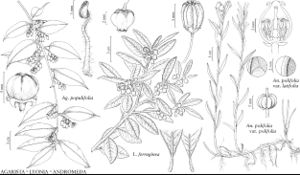Difference between revisions of "Lyonia"
Gen. N. Amer. Pl. 1: 266. 1818, name conserved ,.
FNA>Volume Importer |
FNA>Volume Importer |
(No difference)
| |
Revision as of 23:05, 16 December 2019
Shrubs or trees, (sometimes with woody burl, resprouting after fire). Stems erect to arching; twigs hairy, sometimes glabrescent (sometimes also lepidote). Leaves deciduous or persistent; blade elliptic, obovate, or ovate, membranous to coriaceous, margins entire, undulate, or serrulate [irregularly serrate], plane or revolute, surfaces multicellular, peltate-scaled or short-stalked stipitate-glandular-hairy, often unicellular-hairy on major veins or abaxial surface; venation brochidodromous (or reticulodromous). Inflorescences axillary fascicles, panicles, or racemes, (2–)5–8(–12)-flowered, sometimes flowers solitary, (produced just before flowering). Pedicels: bracteoles 2, at or near base. Flowers: sepals usually [4–]5[–8], slightly connate, ovate-deltate to lanceolate; petals usually [4–]5[–8], connate nearly their entire lengths, white to red, corolla cylindric to urceolate, lobes much shorter than tube, (sparsely stipitate-glandular-hairy or peltate-scaled); stamens usually [8–]10[–16], included; filaments geniculate, flattened, roughened or hairy, with or without spurs; anthers without awns, dehiscent by elliptic pores; pistil usually [4–]5[–8]-carpellate; ovary [4–]5[–8]-locular; (style slightly longer than stamens); stigma capitate-truncate. Fruits capsular, globose to ovoid or ellipsoid, dry, (with [4–]5[–8] pale, decidedly thickened, whitish sutures). Seeds ca. 100–300, ellipsoidal, narrowly oblong, obovoid to angular-obovoid or narrowly conic, (sometimes tailed); testa cells elongate. x = 12.
Distribution
e United States, Mexico, West Indies, e Asia.
Discussion
Arsenococcus Small; Desmothamnus Small; Neopieris Britton
Species 36 (5 in the flora).
Selected References
Key
| 1 | Abaxial surface of leaf blades, pedicels, and calyx lepidote | > 2 |
| 1 | Abaxial surface of leaf blades, pedicels, and calyx nearly glabrous or hairy, not lepidote | > 3 |
| 2 | Ultimate branchlets spreading, flowers nearly always restricted to previous year’s branches; leaves not conspicuously reduced toward branch tips, blade margins usually revolute distally, sometimes strongly so, major veins usually depressed; shrubs or trees to 6(-12) m. | Lyonia ferruginea |
| 2 | Ultimate branchlets rigidly ascending, flowers frequent on current year’s branchlets (some flowers also borne on branches of previous year); leaves conspicuously reduced toward branch tips, blade margins at most slightly revolute distally, major veins not depressed; shrubs to 1.5(-3) m. | Lyonia fruticosa |
| 3 | Leaf blades scattered, multicellular long-headed-hairy abaxially, margins serrulate; corollas urceolate, 2-4(-4.5) mm; calyx lobes 0.5-1.5 mm. | Lyonia ligustrina |
| 3 | Leaf blades scattered, multicellular short-headed-hairy abaxially, margins entire; corollas cylindric, 5-14 mm; calyx lobes 2-9.5 mm | > 4 |
| 4 | Leaves persistent, blade rigidly coriaceous, intramarginal vein present; corollas usually pink, sometimes red or white, 2-5 mm wide, base swollen; filaments roughened; capsules ovoid to ovoid-globose | Lyonia lucida |
| 4 | Leaves deciduous, blade membranous, intramarginal vein absent; corollas usually white, rarely pink, 4.5-9 mm wide, base not swollen; filaments long-hairy, especially near base; capsules ovoid. | Lyonia mariana |
